Ultimate Thailand Travel Guide for 2024 and Five Must-Visit Destinations
Sawasdee kha! Welcome to Thailand, the ultimate holiday destination with something for every traveler. Known as the ‘Land of Smiles,’ Thailand is a well-traveled, tourist-friendly country in Southeast Asia.
Whether you are looking for a family-friendly resort, a luxury romantic getaway, or a backpacking adventure, Thailand can cater to all budgets, interests, and activities. This Thailand travel guide will give you an overview of five top destinations, plus suggested activities, costs, and must-know information before your trip.
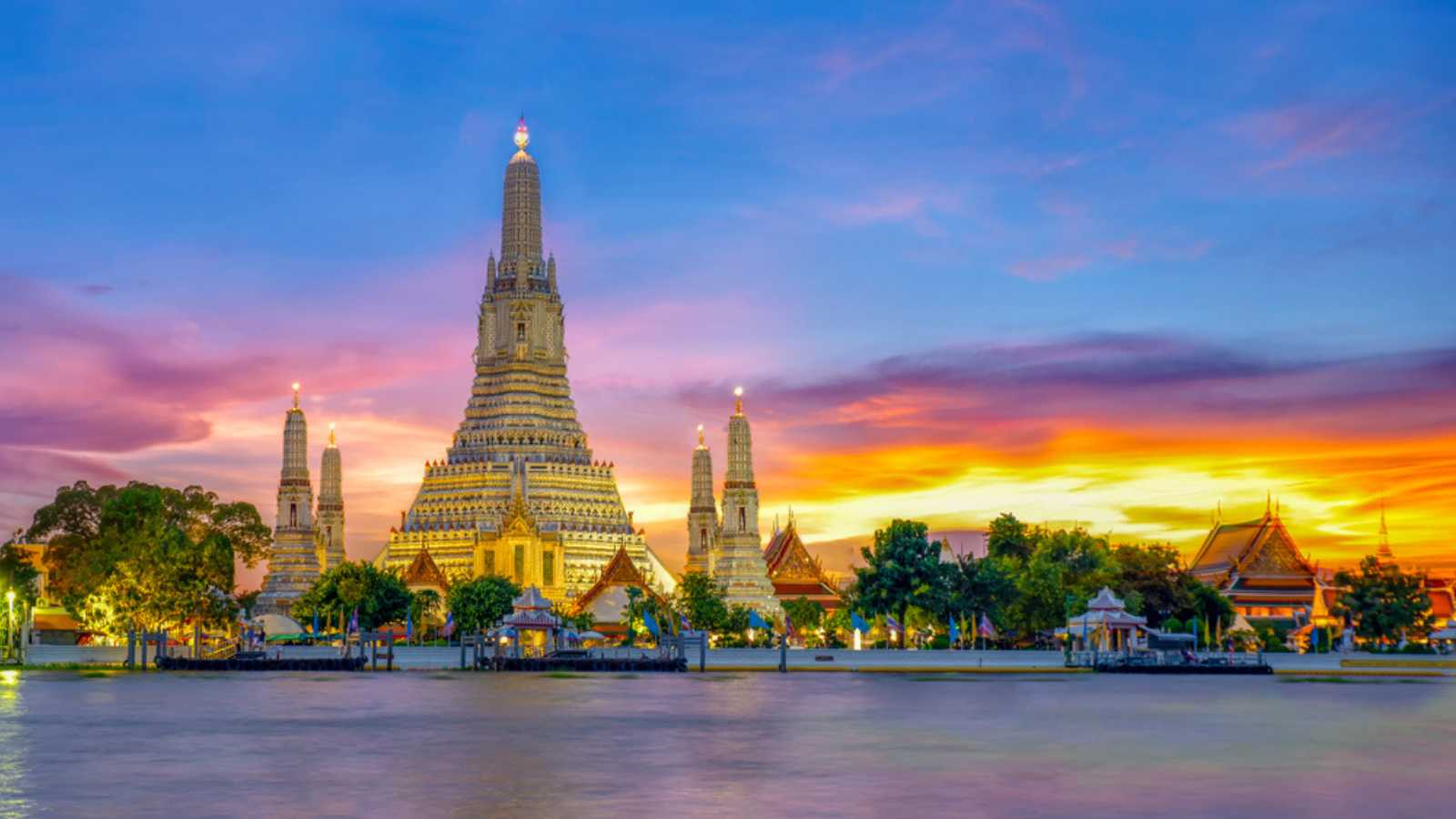
Bangkok: The Capital of Thailand
Bangkok is a large city and business center known for its cultural landmarks, bustling markets, and diverse culinary scene. The city is warm year-round, with temperatures averaging around 86°F, plus the concrete urban landscape intensifies the heat—an ideal destination for urban explorers and culture enthusiasts.
Location: Central Thailand
Population: Approximately 10.5 million
In a nutshell: Urban, Vibrant, Historic, Bustling, Diverse
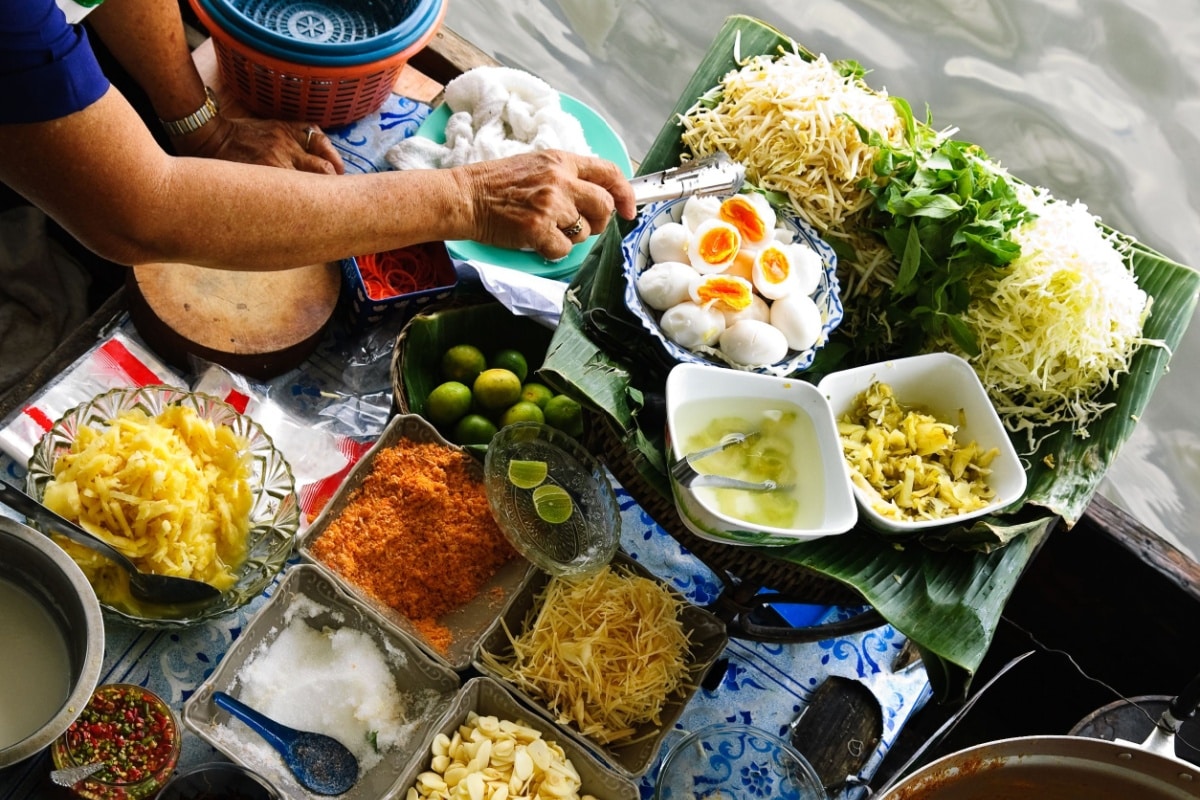
Food
Bangkok is a paradise for food enthusiasts. The city offers a mix of traditional Thai street food and high-end dining experiences. Don’t miss the famous Pad Thai, spicy Som Tum (papaya salad), and the sweet mango sticky rice. For a unique experience, try rooftop dining at places like Vertigo at Banyan Tree, which offers stunning city views.
Ten things to see and do in Bangkok:
- Visit the Grand Palace and Wat Phra Kaew.
- Shop at Chatuchak Weekend Market.
- Explore the historic Wat Arun and Wat Pho temples.
- Party the night away on Khao San Road.
- Sample street food in Chinatown (Yaowarat Road).
- Take a boat tour along the Chao Phraya River.
- Hitch a ride in a Tuktuk.
- Stroll through Lumpini Park.
- Discover art and culture at Bangkok Art and Culture Centre.
- Watch a Muay Thai boxing match.
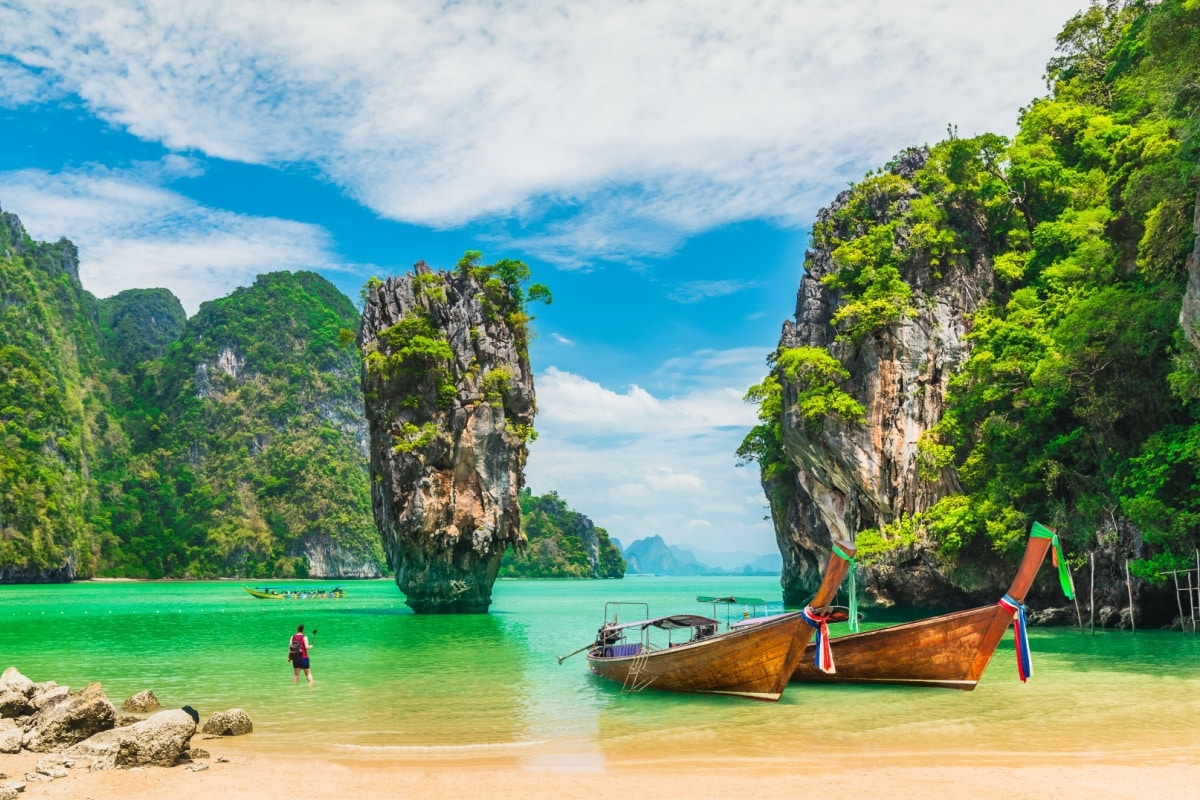
Phuket: Thailand’s Largest Island
Phuket is a top choice among Thailand’s tourist destinations. It is renowned for its picturesque beaches and vibrant nightlife. Well-traveled and very touristy, it caters not only to partygoers but also has resorts suitable for families or couples. If you would like to visit the islands but need more time, you can take day trips to some islands from Phuket.
Location: Southern Thailand
Population: Approximately 416,000
Essence in 5 Words: Tropical, Beaches, Leisure, Vibrant, Picturesque
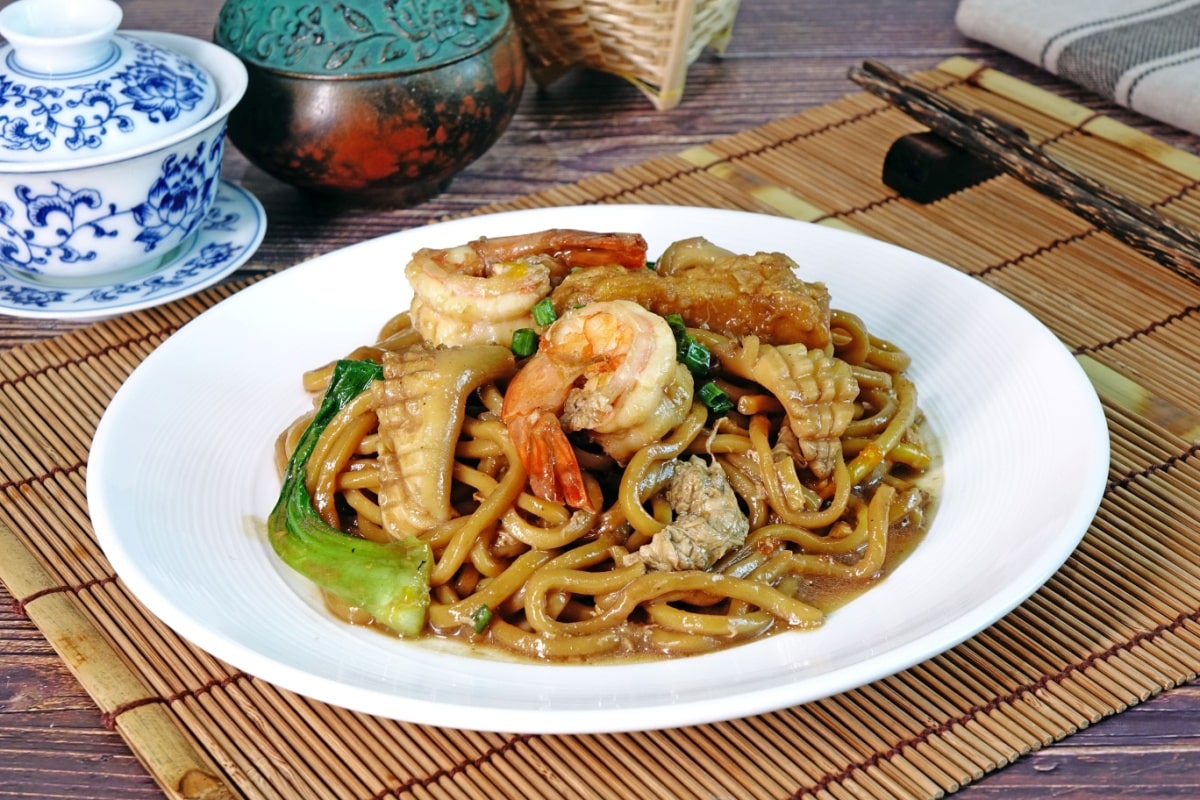
Food
Phuket’s cuisine showcases fresh seafood and Thai flavors, with popular dishes like Mee Hokkien and Moo Hong. The island also offers a variety of international dining options, along with vegetarian and vegan choices.
Ten things to see and do in Phuket:
- Sunbathe and enjoy water sports at Patong Beach.
- Visit the Big Buddha and Wat Chalong temple.
- Enjoy the nightlife on Bangla Road.
- Island hop to nearby destinations like the Phi Phi Islands.
- Snorkel and scuba dive in clear waters.
- Explore Old Phuket Town and its Sino-Portuguese architecture.
- Visit Phuket Elephant Sanctuary.
- Enjoy a traditional Thai massage.
- Take a sea canoe tour in Phang Nga Bay.
- Attend a cultural show at Phuket FantaSea or Siam Niramit.
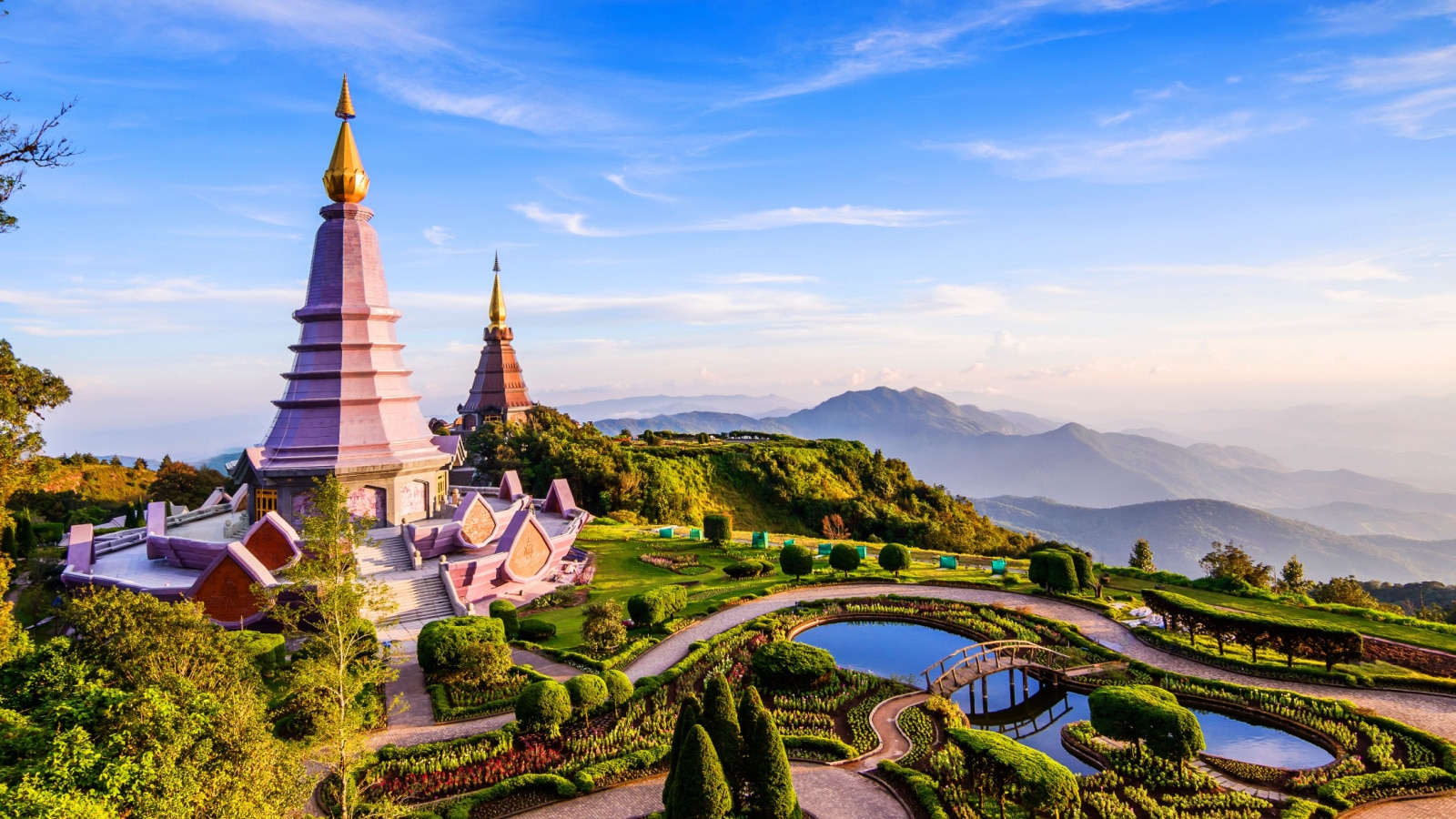
Chiang Mai: Nature and Culture
Chiang Mai is a smaller city that appeals to those seeking a blend of historical richness and natural beauty. It is known for its ancient temples, lush landscapes, and cooler climate. Chiang Mai blends traditional Thai culture and natural beauty, appealing to culture seekers and nature enthusiasts.
Location: Northern Thailand
Population: Approximately 1 million
In a nutshell: Cultural, Serene, Historic, Lush, Artistic
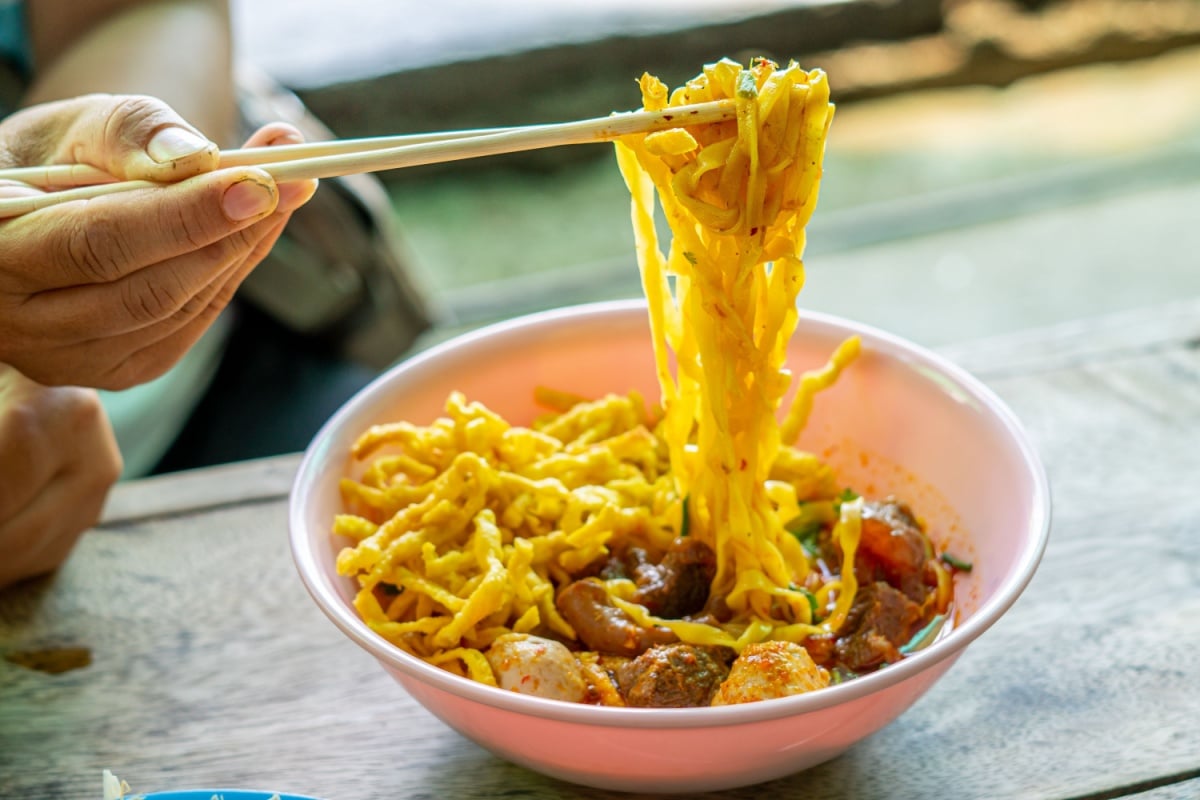
Food
Northern Thai cuisine is quite different from the coconut-based curries of the South. Some local dishes include Khao Soi, a creamy coconut curry noodle soup; Khao Kha Moo, a slow-braised pork leg with a gravy sauce on rice; and Sai Oua, a spicy Chiang Mai sausage. Vegetarian and vegan options are also widely available.
Ten things to see and do in Chiang Mai:
- Explore the ancient city and its temples, like Wat Chedi Luang.
- Visit an ethical elephant sanctuary.
- Trek in Doi Inthanon National Park.
- Take a Thai cooking class or market food tour.
- Experience the Sunday Walking Street Market.
- Hot air balloon rides over the scenic countryside.
- Visit the Hill Tribe villages.
- Zip-line through the jungle.
- Relax at the San Kamphaeng Hot Springs.
- Attend a traditional Thai festival, like Yi Peng.
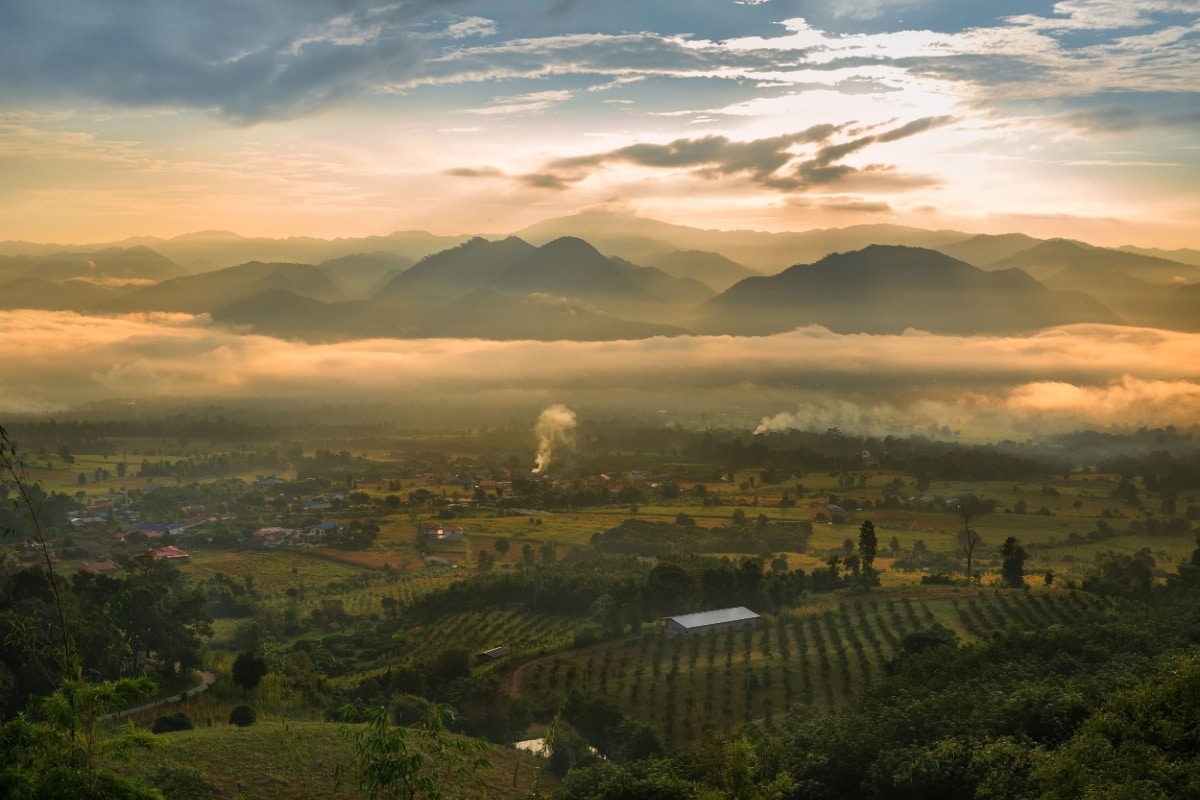
Pai: Tranquil and Scenic
A small town in the mountains of Northern Thailand, Pai is known for its laid-back atmosphere and natural beauty. Less touristy and more of an ‘off the beaten track’ destination, Pai is perfect for travelers seeking a peaceful retreat in nature with a bohemian vibe. Its subtropical highland climate in the mountains results in cooler temperatures than much of Thailand. It appeals to backpackers, artists, and anyone looking to escape the hustle and bustle of city life.
Location: Northern Thailand, in Mae Hong Son Province
Population: Approximately 2,000 (small and intimate community)
In a nutshell: Tranquil, Scenic, Bohemian, Rustic, Adventurous
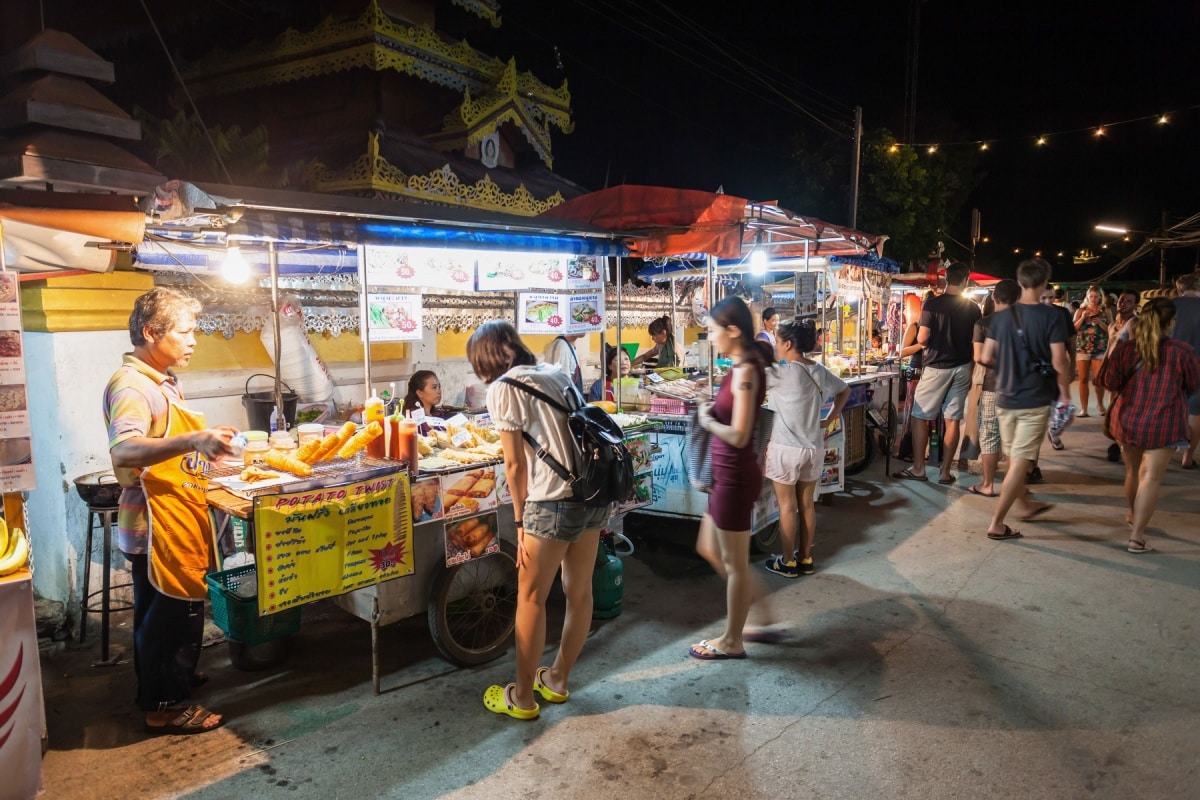
Food
Pai offers a variety of Thai and international cuisines, with a focus on organic and health-conscious options. Local delicacies include fresh river fish dishes, local organic vegetables, and Northern Thai specialties similar to those in Chiang Mai. There’s also a strong presence of plant-based eateries – so if you’re a health-conscious foodie, you don’t have to miss out on your vegan yogurt or chia pudding.
Ten things to see and do in Pai:
- Relax in the Pai hot springs.
- Visit Pai Canyon for stunning views.
- Explore the Tha Pai World War II Memorial Bridge.
- Trek to Mae Yen Waterfall.
- Enjoy the laid-back vibe at Pai Walking Street.
- Experience the local art scene at Pai’s galleries and cafes.
- Bike around the scenic countryside.
- Visit the Bamboo Bridge (Boon Ko Ku So).
- Explore the Lod Cave.
- Watch the sunset at Yun Lai Viewpoint.
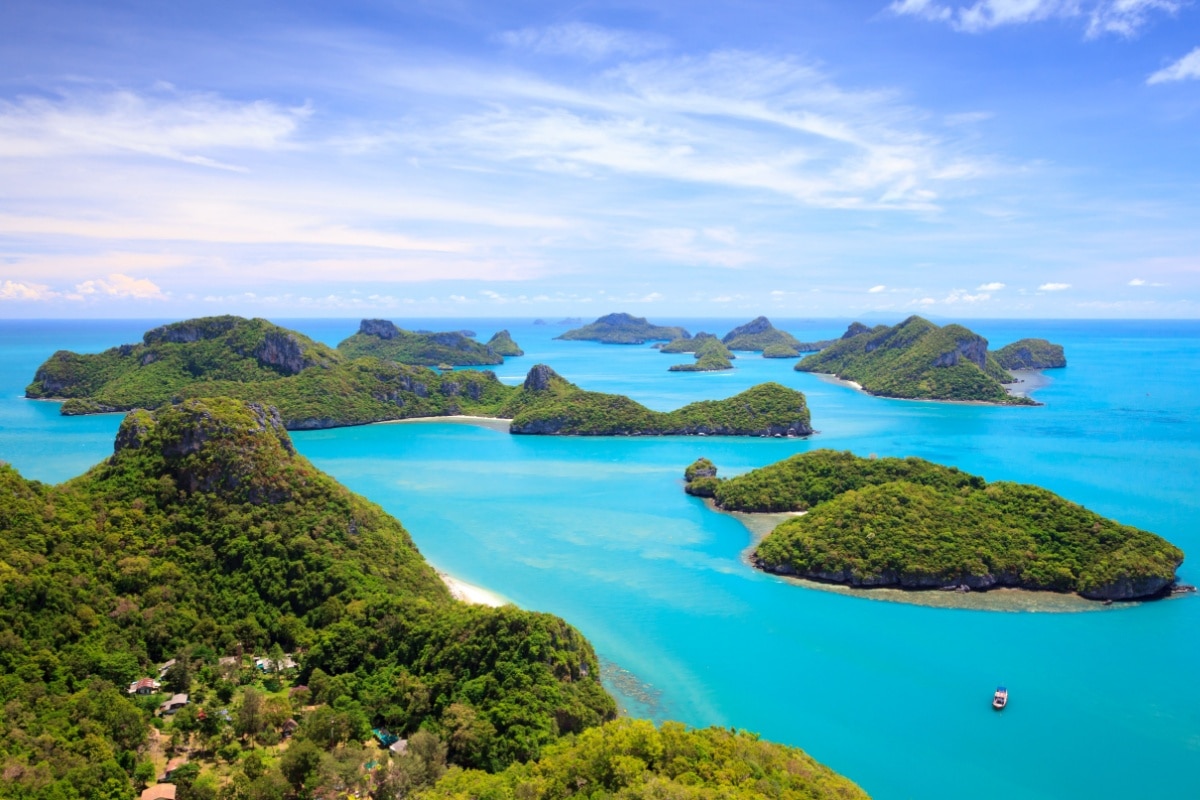
Thailand’s Islands: Idyllic Beaches
The Thai Islands are diverse, but all are renowned for their stunning beaches, clear waters, and vibrant marine life. They attract beach-goers, divers, party-seekers, and those seeking a tranquil escape.
Location: Southern Thailand
Population: Varies by island
In a nutshell: Idyllic, Pristine, Relaxing, Adventurous, Diverse
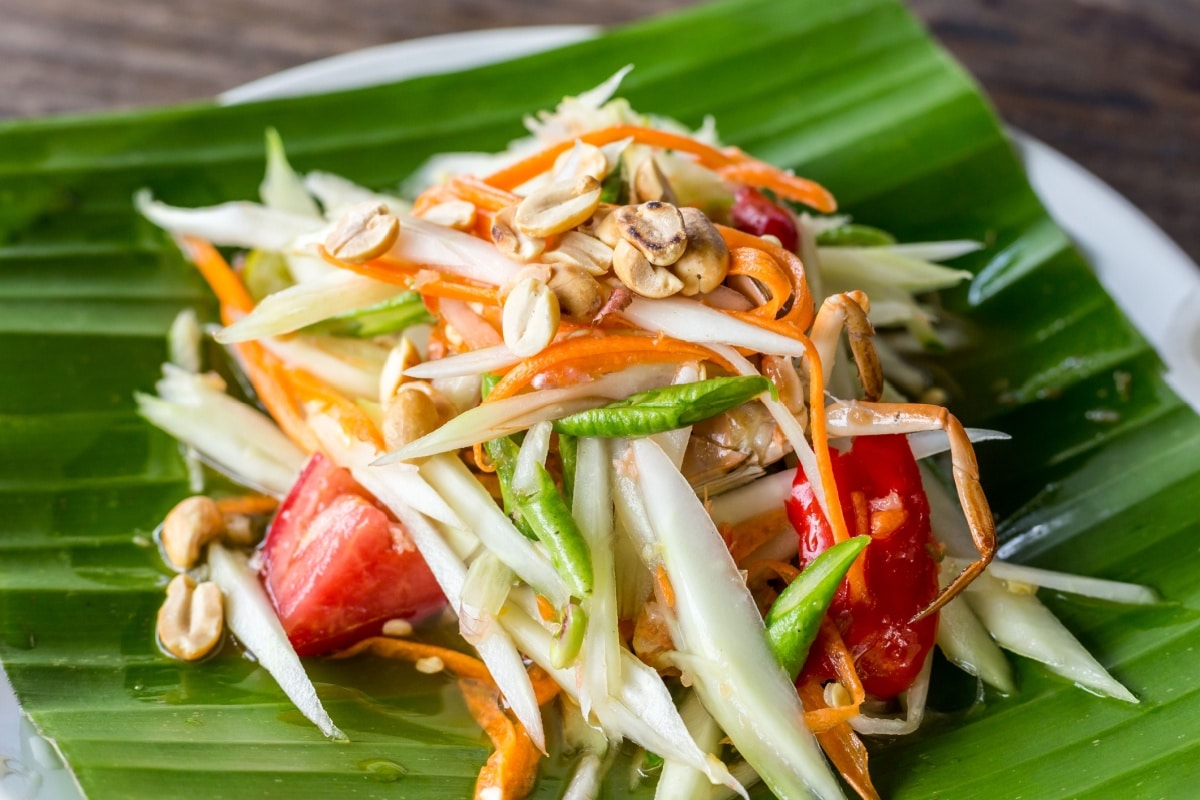
Food
The cuisine across Thailand’s islands often centers around fresh seafood, tropical fruits, and traditional Thai dishes. You’ll find an array of seafood curries, grilled fish, and island specialties like Som Tam (spicy papaya salad). Each island also typically offers international cuisine.
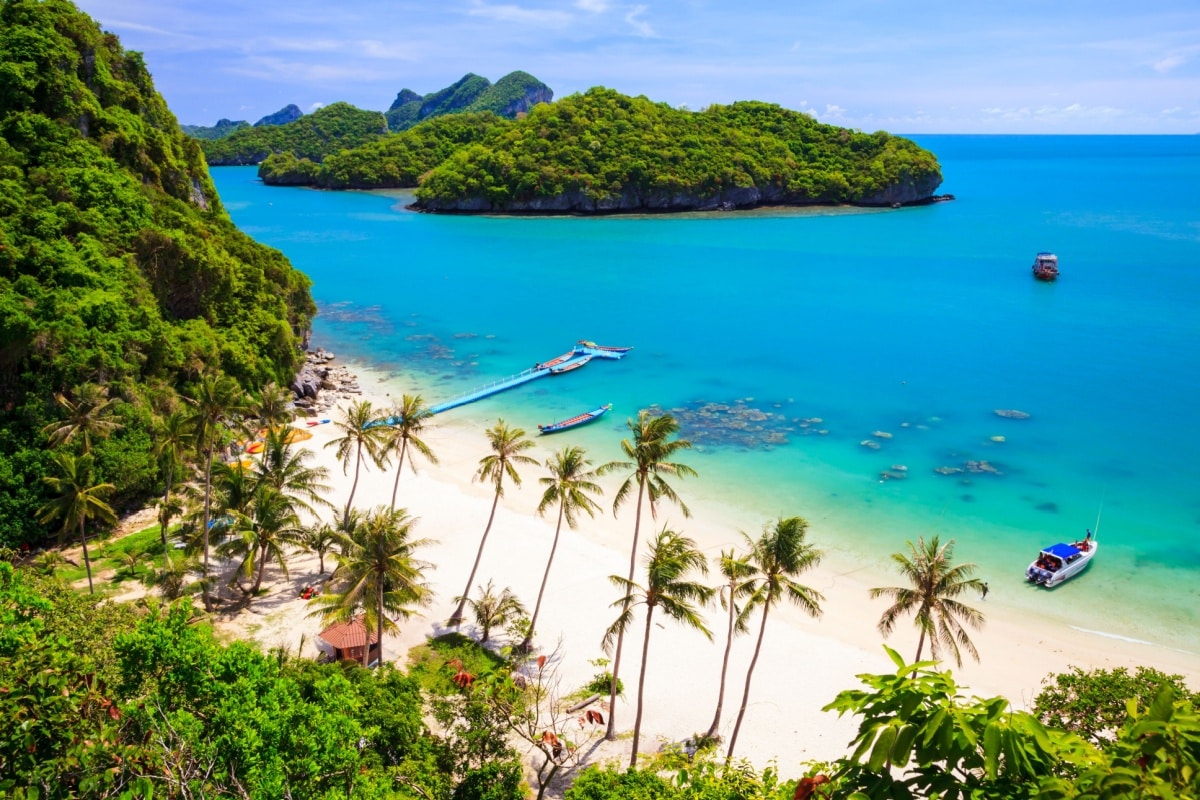
Koh Samui
The second largest island after Phuket, Koh Samui, is home to approximately 65,000 people. It blends the lively atmosphere at Chaweng Beach with serene experiences like Ang Thong National Marine Park and the iconic Big Buddha Temple. It’s accessible through Samui International Airport or by a 1.5 to 2-hour ferry ride from Surat Thani. It is well known for its luxury resorts and spas; it is ideal for families, couples, and wellness enthusiasts.
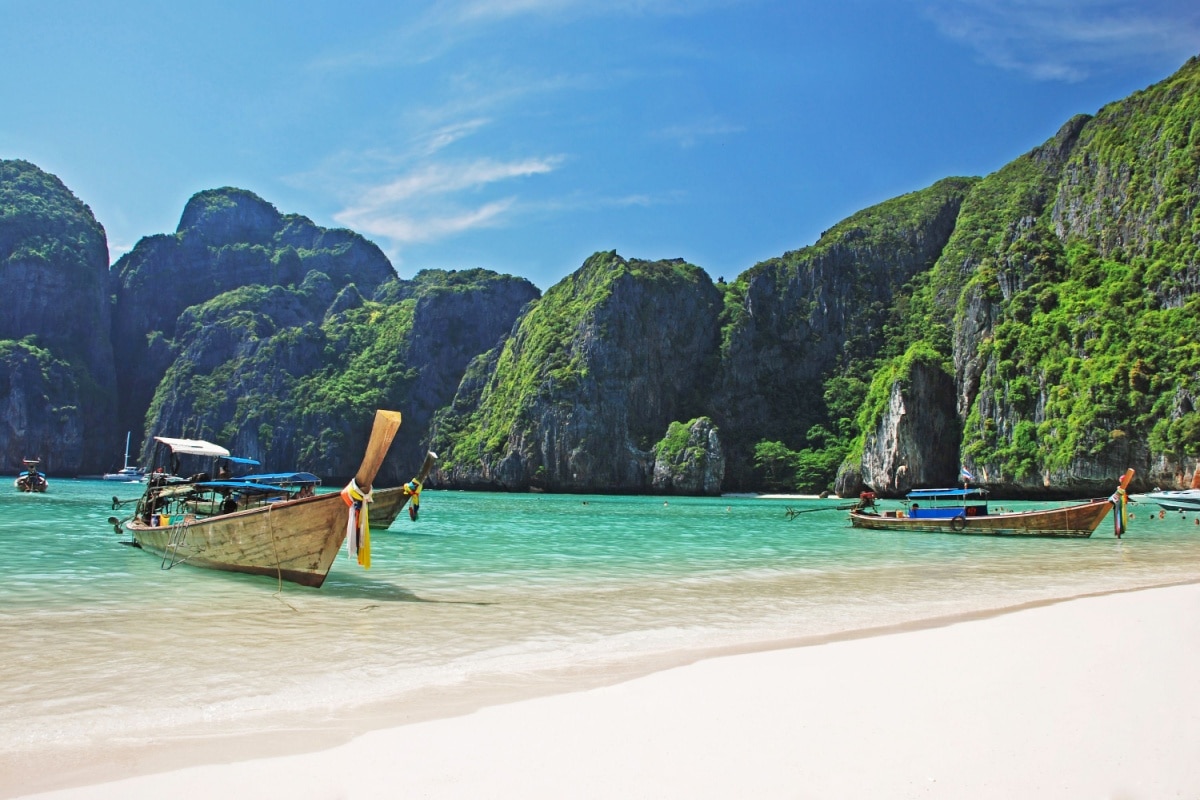
Koh Phi Phi
With a population of around 2,500, Koh Phi Phi is famous for Maya Bay from The Beach movie and its vibrant nightlife, especially on Tonsai Beach. You can reach the island via a 1.5 to 2-hour ferry from Krabi or Phuket, making it suitable for a day trip if you are short on time. The island caters well to adventure seekers and younger travelers, offering excellent scuba diving and snorkeling opportunities.
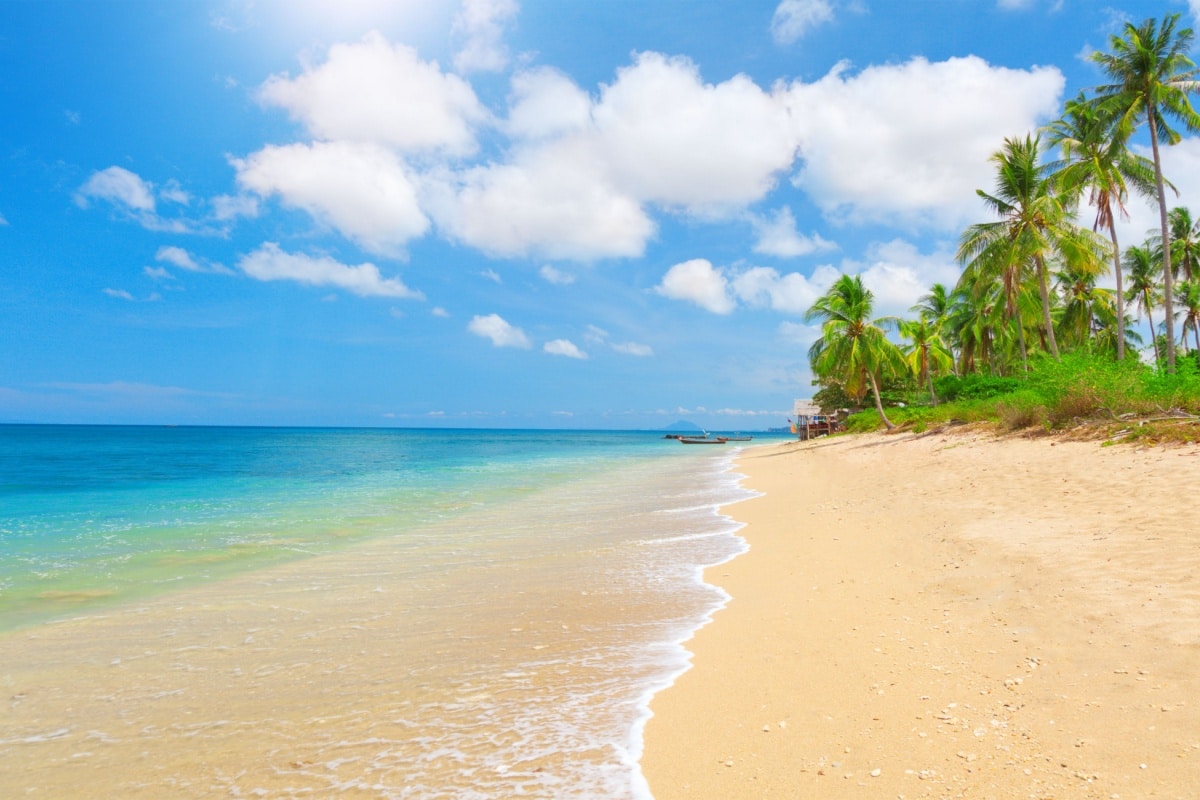
Koh Lanta
Hosting approximately 30,000 residents, Koh Lanta is known for its relaxed Long Beach, the diverse wildlife of Mu Ko Lanta National Park, and the charming Lanta Old Town. The island’s laid-back vibe and natural explorations like kayaking in mangroves make it an excellent choice for families and travelers seeking a quieter retreat. Reachable by ferry from Krabi, Phi Phi, or Phuket (taking 1 to 3 hours) or by driving over a series of bridges from the mainland.
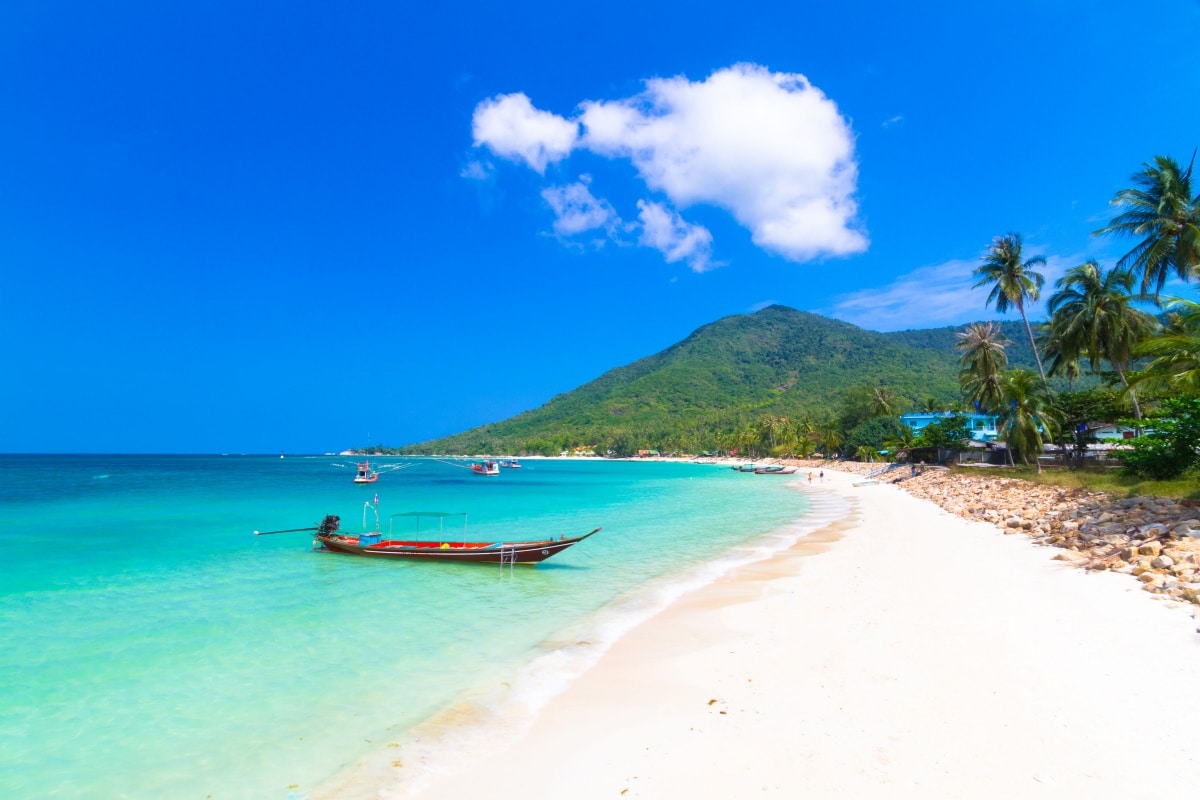
Koh Phangan
With a population of about 12,000, Koh Phangan is renowned for its monthly Full Moon Party. It draws a global crowd to its vibrant all-night beach celebration at Haad Rin Beach. Travel to Koh Phangan typically involves a flight to Koh Samui followed by a ferry ride, taking around 30 minutes to an hour. Apart from the party scene, the island boasts serene beaches, lush jungles, and wellness retreats.
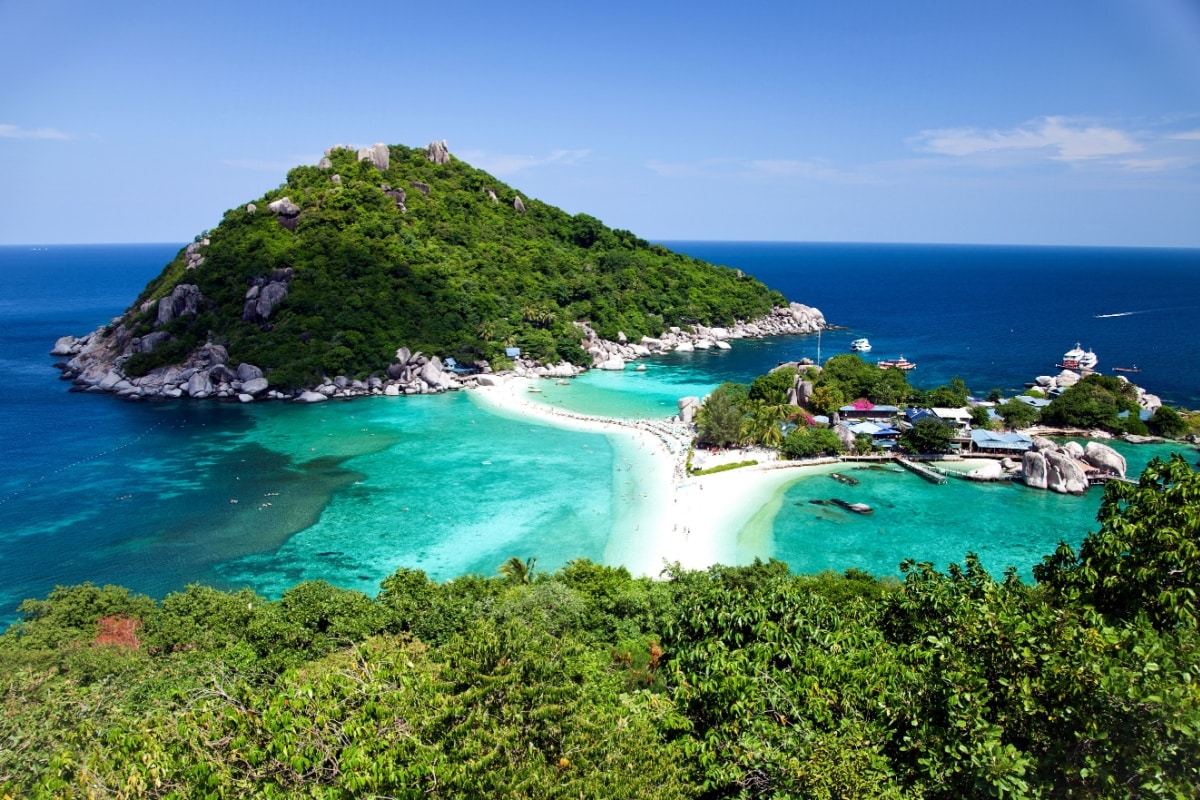
Koh Tao
With a small population of about 1,500, Koh Tao is renowned for Sairee Beach, snorkeling at Shark Bay, and stunning views from John Suwan Viewpoint. Get there via a 1.5 to 3-hour ferry from Chumphon, Surat Thani, or neighboring islands like Koh Samui and Koh Phangan. The island is famous for its scuba diving and wellness retreats. It is perfect for solo travelers, couples, and diving enthusiasts.
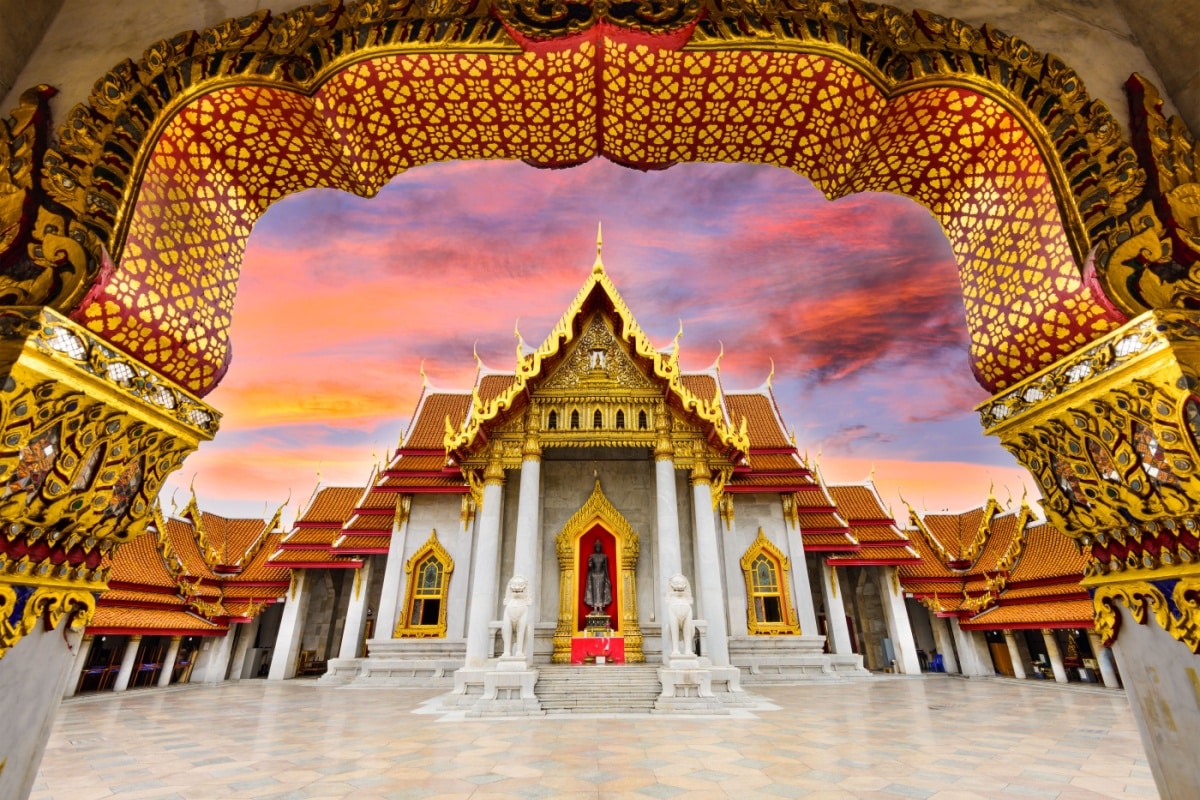
The Best Times To Visit Thailand
Thailand’s peak tourist season is between November and February, coinciding with the dry and (relatively) ‘cool’ season. During this time, temperatures generally range between 68°F to 86°F, with humidity levels around 60-70%. This period is considered the ideal time to travel.
The hot season from March to June sees temperatures soar, often ranging from 86°F to 95°F, sometimes even higher. Humidity levels can hover around 75%, making it feel quite intense. If you don’t mind a bit of heat, it could be an ideal time to save a little on price and hit the island beaches.
The rainy season from July to October brings sporadic downpours and high humidity, with temperatures typically between 77°F to 91°F. The humidity often exceeds 85% during this period. Demand decreases, which means fewer tourists and lower prices. If you’re looking to travel on a shoestring budget and don’t mind the high humidity and rainy weather, this could be the ideal period for your trip.
Food in Thailand
Thailand is a prime destination for foodies. The country’s food scene ranges from cheap eats starting at roughly 50 THB from street food vendors to luxury fine dining, accommodating every taste and budget.
Thai cuisine is distinguished by its emphasis on a balance of four fundamental taste senses: sweet, salty, sour, and spicy. This balance is achieved through the use of various ingredients and cooking techniques:
- Sweet: Commonly derived from palm sugar or coconut sugar, sweetness in Thai dishes often offsets spiciness and sourness. Sweetness is essential in popular dishes like Massaman Curry and Mango Sticky Rice.
- Salty: Fish sauce and soy sauce are primary sources of saltiness in Thai cooking. These condiments add depth and umami to dishes like Pad Thai and stir-fried vegetables.
- Sour: Lime juice and tamarind are Thai cuisine’s most common souring agents. They are essential in dishes like Tom Yum soup and Som Tum salad, providing a refreshing tartness.
- Spicy: Chillies, ranging from mild to intensely hot, are used in various forms – fresh, dried, or as pastes. They are crucial in many Thai dishes, adding heat and flavor complexity.
Dining Experiences in Thailand
Regarding dining experiences, Thai street food vendors are an integral part of the country’s culinary identity. Inexpensive and widely available, it’s common to find grilled meats, noodle soups, and fresh fruit – especially in Bangkok. Mid-range restaurants typically offer a broader menu, often including Thai and international dishes, in a more comfortable setting. Fine dining in Thailand typically combines traditional flavors with contemporary culinary techniques, offering a sophisticated take on classic dishes.
Thai cuisine also varies by region. Northern Thai food often features sticky rice, is less spicy, and includes ingredients like tamarind and turmeric. Dishes from this region include Khao Soi, a creamy curry noodle soup, and Sai Oua, a spicy Chiang Mai sausage. On the other hand, Southern Thai cuisine is known for its intense heat and use of coconut milk. Examples include Massaman Curry, rich with spices, and Tom Yum Goong, a hot and sour shrimp soup.
Central Thai cooking, which consists of the famous Pad Thai, balances all the fundamental tastes and often features rice as the main staple. Each region offers a unique culinary experience, reflecting the diversity of Thailand’s climate, geography, and culture. Numerous cooking schools across Thailand provide classes for those interested in learning Thai cooking. Classes range from short half-day sessions focusing on specific dishes to comprehensive courses covering a wide range of Thai cuisine.
Vegan options are also increasingly available in Thai cuisine. Traditional dishes are often adapted using tofu or legumes as a protein substitute, similar to Thai Chickpea Curry. Soups and sauces can be vegan-friendly by replacing fish sauce with soy sauce and omitting shrimp paste.
Thailand Travel Budgeting: How Much Does It Cost?
Whether you are seeking a luxury escape or backpacking on a shoestring budget, Thailand has an option. The Thai Baht (THB) is the local currency. The current conversion rate is $1 USD equals just over 34 THB.
ATMs are widely available, and most hotels and restaurants accept credit cards. Street food and local markets offer affordable dining and shopping options. Be sure to carry just enough cash throughout the day and safely secure the remaining money in a safe at your accommodation.
Here are some examples of how much you could spend in a day in Thailand, depending on your food, activities, and accommodation.
Budget Traveler
Staying in hostels, eating food from street vendors, using public transport or walking, and mainly doing free or cheap activities (museums, galleries, temples, markets) will set you back approximately 1000-1300 THB ($29-$38 USD) daily.
Mid-Range Traveler
Staying in a standard hotel, with casual restaurant dining, taxis, and paid activities (shows, cooking classes, massage, and sanctuary visits), will cost approximately 1800–2500 ($52-$73 USD) THB daily.
Luxury Traveler
Luxury travel costs will vary widely; however, as a gauge, spending 4000 (just over $116 USD) THB and upwards per day will get you a luxurious experience at premium resorts, fine dining, private cars, and experiences.
Local Transportation: Getting Around in Thailand
Tuk-Tuks
These iconic three-wheeled vehicles are a fun way to navigate shorter distances. Agree on the fare before starting your journey – don’t be afraid to barter.
Motorbike Taxis
For solo travelers, motorbike taxis are a quick way to get around, especially in traffic-congested areas. Always wear a helmet for safety, and check your travel insurance covers you for any injuries if there is an accident.
Buses and Trains
For longer distances, buses and trains offer affordable and scenic travel options. Sleeper trains are famous for overnight journeys, especially from Bangkok to Chiang Mai.
Renting Scooters
Renting scooters is a common way to explore, especially in beach areas and smaller towns. However, proceed cautiously, as accidents can be dangerous and even result in death. Ensure you have a valid international driver’s license and always wear a helmet. Ensure that your travel insurance policy covers injuries, as it may exclude scooters and motorbikes due to their high risk.
Accommodation Options in Thailand: Finding Your Perfect Stay
Thailand offers diverse accommodation options to suit various preferences and budgets. From luxurious resorts to budget-friendly hostels to unique bungalows and island huts – there’s something for every type of traveler.
Luxury Resorts and Five-Star Hotels
Best for: Travelers seeking comfort, high-end amenities, and exceptional service.
Features: These establishments often feature exquisite rooms, on-site dining options, spa services, and sometimes private beaches or pools. Buffet breakfast spreads are impressive, with fresh fruit, cereals, yogurt, and local cuisine.
Locations: Common in major tourist destinations like Bangkok, Phuket, and Koh Samui.
Boutique Hotels and Villas
Best for: Those looking for a unique, intimate experience with personalized service.
Features: Boutique accommodations often have a distinct style or theme, offering a blend of luxury and local charm.
Locations: Spread across Thailand, particularly in urban areas and popular island destinations.
Mid-Range Hotels
Best for: Families and couples looking for a comfortable stay without the luxury price tag.
Features: These hotels provide good comfort with standard amenities like air conditioning, in-house restaurants, and sometimes a pool.
Locations: Found in all major cities and tourist spots.
Budget Hotels and Guesthouses
Best for: Solo travelers, backpackers, and those on a tight budget.
Features: Basic accommodations, often with a private room and sometimes a shared bathroom. Amenities are limited but sufficient for a comfortable stay.
Locations: Widely available across the country, especially in backpacker areas.
Hostels
Best for: Solo or young travelers and backpackers looking for affordable stays and social environments.
Features: Dormitory-style sleeping arrangements, communal spaces for socializing, and kitchen facilities. Private rooms are often available too.
Locations: Common in Bangkok, Chiang Mai, and other tourist hubs, as well as off-the-beaten-path locations.
Vacation Rentals and Apartments
Best for: Families and groups or travelers seeking a home-like experience.
Features: Offers more space and privacy, with facilities like a kitchen, living area, and multiple bedrooms. You can also arrange for private chefs, cleaners, and nannies.
Locations: Available throughout Thailand, particularly in cities and popular tourist areas.
Eco-Lodges and Sustainable Stays
Best for: Eco-conscious travelers and nature lovers.
Features: Focus on sustainability and eco-friendliness, often in natural settings and offering experiences like jungle treks or wildlife watching.
Locations: Found in more remote areas, near national parks or rural settings.
Beach Bungalows and Island Huts
Best for: Beach lovers and those looking for a laid-back, rustic experience.
Features: Simple, often wooden structures near or on the beach offer a more relaxed vibe. Air conditioning is often not available.
Locations: Common on islands and coastal regions.
Visas
Americans can enter Thailand without a visa for stays up to 30 days. Obtain a tourist visa from a Thai embassy or consulate for more extended visits. Visit the U.S. Embassy or your home country’s government website for more information and guidance.
Language Guide: Useful Phrases To Know
Thailand is a very tourist-friendly destination, so you don’t need to worry about not speaking the language—most staff working in the travel industry will speak English. Printing off any hotel addresses or travel destinations written in the Thai alphabet is practical as this will help communication run smoothly with drivers. When bartering at markets or when ordering food, it’s easy enough to get by with gestures and essential words.
However, if you would like to learn some basic phrases to say on your trip, it is a thoughtful and respectful way to engage with the locals. Here are some basic everyday phrases that may be helpful:
- Hello: Sawasdee (krab/kha)
- Thank you: Khop Khun (krab/kha)
- Yes: Chai (krab/kha)
- No: Mai (krab/kha)
- How much?: Tao rai?
- Too expensive: Paeng pai
- Delicious: Aroy
- Bathroom: Hong Nam
Note: ‘krab’ for men (for men) and ‘kha’ (for women) are added to the end of sentences to be polite. As a woman traveling in Thailand, I would say ‘Sawasdee kha’ as ‘Hello.’
Things To Be Careful of and What Not To Do in Thailand
Traveling to Thailand is an exciting experience, but like any destination, it has its cultural norms and legal regulations. Being aware of these can ensure a safe and respectful visit. Here are some key things to be mindful of and what not to do while in Thailand:
Respect the Monarchy
Thailand holds its royal family in high esteem. Disrespecting the monarchy, in any form, is not only frowned upon culturally but is also illegal. Criticizing or speaking ill of the royal family can lead to severe penalties under Thai law.
Dress Appropriately in Temples
When visiting temples, dress conservatively. Cover your shoulders and knees, and remove your hat. It’s a sign of respect in these sacred places.
Don’t Touch Heads or Point Your Feet
The head is considered the most sacred part of the body in Thai culture, so never touch someone’s head, not even children. Similarly, pointing your feet at people, especially at Buddha images, is seen as highly disrespectful.
Avoid Public Displays of Affection
Thailand is conservative when it comes to public displays of affection. Holding hands is acceptable, but kissing and hugging in public are frowned upon.
Don’t Disrespect the Buddha
It’s illegal and disrespectful to deface, damage, or disrespect images of Buddha. Consider tattoos, clothing, or accessories with Buddha images as offensive.
Be Cautious With Alcohol Consumption
While Thailand has a vibrant nightlife, it’s essential to consume alcohol responsibly. Public drunkenness can lead to trouble, and there are strict laws against drinking in temples, public offices, and other specific public areas.
Be Aware of Human Rights and Animal Exploitation
It’s essential to be aware that in Thailand’s nightlife, especially in places like Bangkok, adult entertainment like the infamous’ ping pong shows’ may involve trafficked and exploited individuals. Avoid these venues.
Popular tourist activities like elephant rides, tiger temples, and wildlife shows often entail animal cruelty. Opt for ethical wildlife sanctuaries and conservation efforts that ensure animal welfare and conservation.
Don’t Engage in Illegal Drugs
Thailand has stringent drug laws, and penalties for possession, use, or trafficking of illegal drugs are severe, including lengthy prison sentences or even the death penalty.
Be Wary of Scams
Be cautious of common tourist scams, such as tuk-tuk drivers taking you to a gem shop, overly friendly strangers offering unsolicited help, or inflated tourist prices. Always agree on prices before receiving a service. If cars honk at you or a stranger approaches you, it’s best to ignore them and keep moving.
Avoid Sensitive Topics in Conversations:
Steer clear of discussing sensitive political topics, particularly those related to the Thai government or monarchy. Avoiding any conversation interpreted as critical of the country’s politics or leadership is best.
Discover a world of experiences in Thailand, from the busy streets of Bangkok to the serene beaches of the islands. Remember to immerse yourself in the local culture, savor the delicious cuisine, and travel responsibly. Whether you’re a seasoned traveler or planning your first trip to Thailand, there’s always something new and exciting to explore. Share your experiences and tips in the comments, and don’t forget to check out more travel guides. Sawasdee kha and happy travels!
This article originally appeared on Wealth of Geeks.

